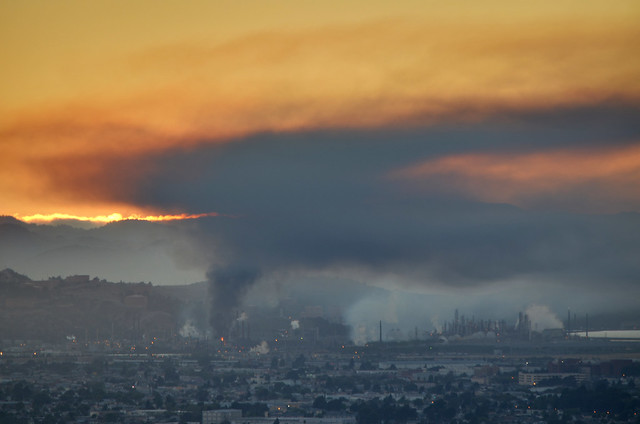Earth Island Journal, Feb. 13, 2014
by Zoe Loftus-Farren
The movement has had some big victories, but environmental racism continues to plague frontline communities
In 1982, protestors lay down in the streets, using their bodies to block the delivery of 6,000 truckloads of toxic PCB-laced soil headed for a landfill in the poor, African-American community of Afton, North Carolina. This act of civil disobedience is widely credited with sparking the environmental justice movement and drawing national attention to the disproportionate impact that frontline communities of color and low-income communities face from toxic pollution.
 Photo by Daniel ParksFile photo of a 2012 fire at Chevron’s refinery in Richmond, CA, which has a large African American, Hispanic, and Asian population. Communities of color and low-income communities continue to face a disproportionate burden of environmental pollution.
Photo by Daniel ParksFile photo of a 2012 fire at Chevron’s refinery in Richmond, CA, which has a large African American, Hispanic, and Asian population. Communities of color and low-income communities continue to face a disproportionate burden of environmental pollution.
Twelve years after the Afton protests — and after several studies documenting how the majority of toxic waste sites were located near either poor or non-white communities, as well as multiple failed attempts to pass an environmental justice bill through congress — President Clinton signed Executive Order (EO) 12898. The order required federal agencies to consider and address the ways in which their policies affect the health and environment of low-income communities and communities of color. This week, President Clinton’s environmental justice order turned 20, offering an opportunity to reflect on how far the movement has come during the past two decades.
EO 12898 lent the environmental justice movement both symbolic and practical support by placing it on the federal stage. “It was the first executive order to deal with environmental justice,” says Robert Bullard, who is broadly referred to as the father of environmental justice. “The fact that Clinton elevated environmental justice as something that was worthy of an Executive Order was something that was symbolic and was historic.”
The order, accompanied by the tireless efforts of advocates, also provoked action at the state level. “A lot has been achieved over the last 20 years and there is still a lot of work that is needed,” says Bullard, who is now dean of the Barbara Jordan-Mickey Leland School of Public Affairs at Texas Southern University. “For example, when the executive order was signed in 1994, there were just a couple of states that had environmental justice laws, or Executive Orders, or policies to deal with environmental justice. And today, every state in the country has some kind of environmental justice law, or Executive Order, or policy – [though] all of the regulations are not created equal.”
Bullard also points out how the movement has grown beyond the legal sphere. While environmental justice was just entering the public dialogue in the 1990s, today almost every university has a course on environmental justice, and dozens of universities have established environmental justice centers and legal clinics focused exclusively on these issues. And while the First National People of Color Environmental Leadership Summit identified roughly 300 environmental justice organizations in the US in 1991, Bullard estimates that there are now several thousand such organizations across the country.
The movement has also won concrete victories, including successful campaigns against the unjust siting of hazardous and nuclear waste facilities and large financial settlements to compensate for historical pollution. For example, in 2001, Native American activists blocked the siting of a nuclear waste dump in the Mojave Desert in California, and in 2003 a community in Anniston, Alabama won a $700 million settlement against Monsanto and Solutia Inc. for local PCB contamination.
Some contaminated communities have also received assistance with much needed cleanup efforts, including an $18 million effort to clean up the Afton PCB landfill.
Though environmental justice efforts stalled at the federal level during the Bush Administration, the Obama Administration has brought attention back to the movement, particularly through the appointment of Lisa Jackson to head the EPA, and the issuance of a Memorandum of Understanding on Environmental Justice and Executive Order 12898, which established the Interagency Working Group on Environmental Justice.
But the battle is far from won. EO 12898 has never been fully implemented, and low-income communities and communities of color continue to face a disproportionate burden of our health and environmental ills, including disproportionate exposure to hazardous air pollution, lead, pesticides, and contaminated drinking water.
This burden will likely increase alongside climate change. “I see climate change as the number one environmental justice issue of our time,” said Bullard. “The fact is that again, the communities that contribute the least to climate change are the communities that feel the negative impacts first, worst, and longest. These are the places where we will see the justice and equity issues up close and personal. They are not theoretical.”
On the twentieth anniversary of EO 12898, the EPA finally seems to be stepping up to the plate with the launch Plan EJ 2014 — a strategy to integrate environmental justice into all of the EPA’s activities, the exact action that was called for in Clinton’s Executive Order. Let’s hope that other agencies, at both the state and federal levels, will follow suit. Because as Bullard says: “We still have environmental racism, we still have unequal protection, we still have communities on the front lines that are allowed to face elevated risks… We still have to keep pressing that all communities have equal protection under the law.”
Zoe Loftus-Farren
Zoe Loftus-Farren is an intern at Earth Island Journal. She holds a J.D. from the University of California, Berkeley, School of Law, and has experience working on issues concerning climate change, environmental justice, food policy and endangered species.


Environmental Justice Advocates Testify in Trenton on the Proposed Clean Energy Standard